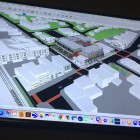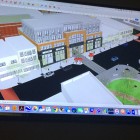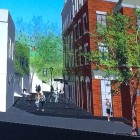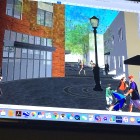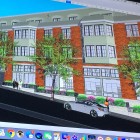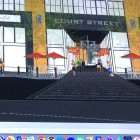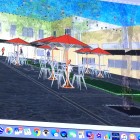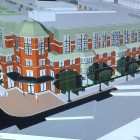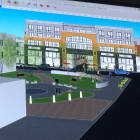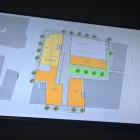Updated 5:54 p.m. September 13, 2016 with information on the number of school-age children moving into new developments:
There was a bit of a buzz at the South Orange Development Committee meeting on September 8.
Dean Marchetto, who recently received the prestigious honor of being named an American Institute of Architects Fellow, was presenting a preliminary proposal for a mixed-use development at Vose Avenue and South Orange Avenue in South Orange Village Center.
Marchetto, through the work of his Hoboken-based firm Marchetto Higgins Stieve, is known for mixed-use multi-unit housing developments that respect their environment but push the envelope a bit architecturally. The firm is credited in part with the transformation of Hoboken, with more than 100 projects in the city.
Likewise Marchetto has been at the helm for projects in towns that are more similar to South Orange — namely Madison and Westfield.
The plan Marchetto presented on September 8 was very preliminary — more of a conceptual presentation to gain feedback on massing and density — with final design details to come later.
Marchetto presented a plan that would consolidate a number of properties mostly on the western portion of the block bordered by South Orange Avenue, Vose Avenue, Taylor Place and Scotland road (including the old Blockbuster site) in South Orange Village Center. The plan called for two covered arcades and one alley leading to an interior courtyard, 17,500 sf of ground-floor retail, 130 apartment units, 130 underground parking spaces for housing tenants and 75 garage parking spaces for visitors and shoppers.
Members of the development committee, which includes a number of local residents who work as architects, planners and developers, and which reports to the Board of Trustees in an advisory capacity, were impressed with the project in that it “had more than one look” breaking up the potential superblock impression that such a large-scale project could make.
After reviewing some of Marchetto’s projects for other clients, some committee members encouraged him to push the envelope a bit more with design. “We are a little edgier than Morristown,” said one. Another added, “We’re proud of our historic buildings, but you don’t need to mimic.”
Design aside, numerous committee members noted that they would like to see “one floor knocked off” the building, which, as proposed, looks to be one story higher than The Avenue. (The proposed new building is 61′ high at Vose Avenue, while The Avenue is 52′ high on Vose; the proposed building reaches 55′ on South Orange Avenue.)
Marchetto argued throughout his presentation that the developers (Les and Jared Lustbader) had stipulated that 130 units of housing were needed to make the project financially viable, thus dictating the height of the project. He also noted that he had worked to mitigate the height through setbacks and architectural details. In order to bring down the height of the building, said Marchetto, public space and amenities would be lost.
Village President Sheena Collum said that the Village’s consulting financial analyst would review the project.
The Village also has a major bargaining chip in this game: The Lustbader’s are looking to use a 50-space public parking lot as part of the development.
A number of committee members were also concerned that the interior courtyard would not see sufficient traffic. Although Marchetto had shown numerous slides from trips to Venice that inspired the creation of the space, one committee member pointed out, “This is not Venice.” Although committee members found the idea “cool” and were sympathetic to it, they expressed concerns that there would not be enough foot traffic to make the space safe or commercially viable.
Committee members discussed the potential for senior housing at the project, as well as housing for Seton Hall University junior faculty and graduate students.
Marchetto said that the new residents (as well as those from other developments at the Gateway, Third & Valley and so on) would populate the interior courtyard space and that night-time lighting and security could be used to protect the space. The idea of gates was rejected on both sides.
Collum noted that the criticism with Third & Valley was that it lacked sufficient community access. “I love this,” said added. “It’s inclusive.”
Ultimately committee members felt that the success of the arcades, alleys and interior courtyard would depend on through-traffic from Spiotta Park on one side through to the South Orange Public Library parking lot on the other — relying on perhaps a grander vision for the development of the Village Center.
When the conversation came back to size, Collum said that at 92 units per acre, the proposed project was significantly more dense than Third & Valley (78 units/acre).
She said that next steps would include a pro forma and financial analysis. She seemed to indicate that the Village was in a good place from a bargaining standpoint: “There is a lot of certainty for developers coming here,” Collum said, noting the recent profitable sale of The Gateway.
Collum brushed aside concerns about any strain that multiple housing developments in South Orange could put on the school district, saying that such projects in South Orange had not brought in substantial numbers of school age kids.
In a followup email, Collum detailed that developments such as “The Gateway, The Avenue, Mews, Gaslight, and Ridgewood Commons are bringing in kids at a 1 per 30 unit to 40 unit ratio. So that means that a 100-unit development may bring 3 kids or less. “And many of those kids were once already in the district and through separations (etc.) an existing parent went into a rental.”
However, she admitted that strain on the transportation infrastructure was a concern. “That’s the largest concern of mine,” said Collum, who criticized the “short-sightedness” of Gov. Christie in canceling the ARC tunnel project but said that town officials continued to meet with state legislators and NJ Transit about the issue.
One committee member noted, “If we don’t develop, other towns along the line will and take our seats.”
Click on photos to enlarge:

